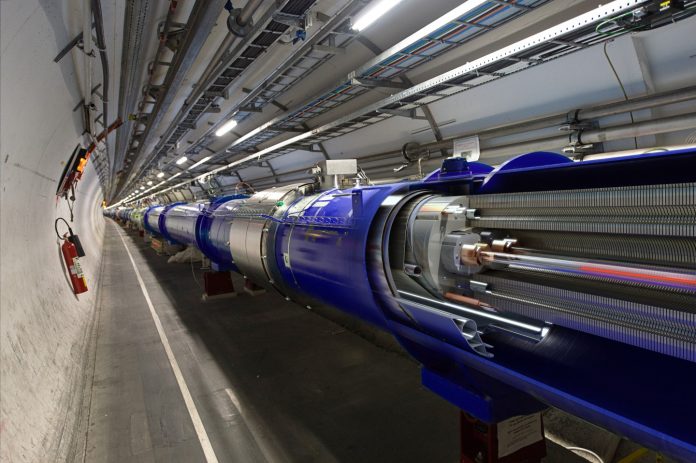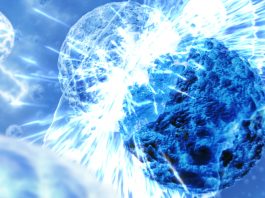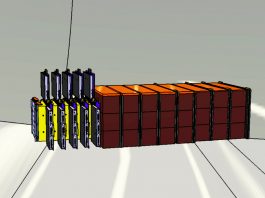CERN’s Large Hadron Collider (LHC) Run 3 is set to launch after three years of upgrade and maintenance work.
A new period of data collection begins Tuesday 5 July 2022 for experiments at the world’s most powerful particle accelerator, the Large Hadron Collider (LHC), after more than three years of upgrade and maintenance work. Beams have already been circulating in CERN’s accelerator complex since April 2022, with the LHC machine and its injectors being recommissioned to operate with new higher-intensity beams and increased energy.
LHC stable beams
Now, the LHC operators are ready to announce “stable beams”, the condition allowing the experiments to switch on all of their subsystems and begin collecting the data that will be used for physics analysis. The LHC will run around the clock for close to four years at a record energy of 13.6 trillion electronvolts (TeV), providing greater precision and discovery potential than ever before.
“We will be focusing the proton beams at the interaction points to less than 10-micron beam size, to increase the collision rate,” explained Mike Lamont, Director for Accelerators and Technology. “Compared to Run 1, in which the Higgs was discovered with 12 inverse femtobarns, now in Run 3 we will be delivering 280 inverse femtobarns1. This is a significant increase, paving the way for new discoveries.”
Upgrading the LHC experiments
The four big LHC experiments have performed major upgrades to their data readout and selection systems, with new detector systems and computing infrastructure. The changes will allow them to collect significantly larger data samples, achieving higher quality than in previous runs. The ATLAS and CMS detectors expect to record more collisions during Run 3 than in the two previous runs combined. The LHCb experiment underwent a complete revamp and looks to increase its data taking rate by a factor of ten, while ALICE is aiming at a staggering fifty-fold increase in the number of recorded collisions.
With the increased data samples and higher collision energy, Run 3 will further expand the already very diverse LHC physics programme. Scientists at the experiments will probe the nature of the Higgs boson with unprecedented precision and in new channels. They may observe previously inaccessible processes and will be able to improve the measurement precision of numerous known processes addressing fundamental questions, such as the origin of the matter–antimatter asymmetry in the Universe.
Scientists will study the properties of matter under extreme temperature and density and will also be searching for candidates for dark matter and for other new phenomena, either through direct searches or – indirectly – through precise measurements of the properties of known particles.
“We are looking forward to measurements of the Higgs boson decay to second-generation particles such as muons. This would be an entirely new result in the Higgs boson saga, confirming for the first time that second-generation particles also get mass through the Higgs mechanism,” commented CERN theorist, Michelangelo Mangano.
“We will measure the strengths of the Higgs boson interactions with matter and force particles to unprecedented precision, and we will further our searches for Higgs boson decays to dark matter particles as well as searches for additional Higgs bosons,” explained Andreas Hoecker, spokesperson of the ATLAS collaboration. “It is not at all clear whether the Higgs mechanism realised in nature is the minimal one featuring only a single Higgs particle.”
Analysing lepton flavour asymmetry
A new focus will be on a class of rare processes in which an unexpected difference (lepton flavour asymmetry) between electrons and their cousin particles, muons, is to be studied by the LHCb experiment in the data from previous LHC runs.
“Data acquired during Run 3 with our brand-new detector will allow us to improve the precision by a factor of two and to confirm or exclude possible deviations from lepton flavour universality,” explained Chris Parkes, spokesperson of the LHCb collaboration. Theories explaining the anomalies observed by LHCb typically also predict new effects in different processes. These will be the target of specific studies performed by ATLAS and CMS. “This complementary approach is essential; if we are able to confirm new effects in this way it will be a major discovery in particle physics,” said Luca Malgeri, spokesperson of the CMS collaboration.
Investigating quark–gluon plasma
The heavy-ion collision programme will allow the investigation of quark–gluon plasma (QGP) – a state of matter that existed in the first 10 microseconds after the Big Bang – with unprecedented accuracy. “We expect to be moving from a phase where we observed many interesting properties of the quark–gluon plasma to a phase in which we precisely quantify those properties and connect them to the dynamics of its constituents,” added Luciano Musa, spokesperson of the ALICE collaboration. In addition to the main lead–lead runs, a short period with oxygen collisions will be included for the first time, with the goal of exploring the emergence of QGP-like effects in small colliding systems.
Launching LHC Run 3
The launch of LHC Run 3 will be streamed live on CERN’s social media channels and high-quality Eurovision satellite link starting at 4.00 p.m. (CEST) on 5 July 2022. Live commentary from the CERN Control Centre, available in five languages (English, French, German, Italian and Spanish), will walk the viewers through the operation stages that take proton beams from injection into the LHC to collisions for physics at the four interaction points where the experiments are located. A live Q&A session with experts from the accelerators and experiments will conclude the live stream.





